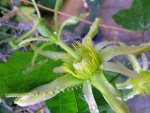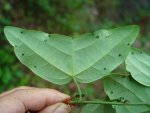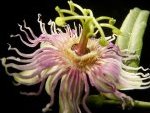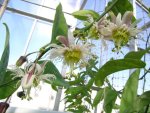| |
Passiflora Supersect. Disemma
Passiflora Supersect. Disemma (Labill.) J. M. MacDougal & Feuillet. Passiflora 13(2): 37. 2003 [2004]. Basionym:
Disemma Labill. Sert. Austro-Caledon. 78, t. 79. 1824 [1825].

Passiflora herbertiana from Australia, with tube-shaped operculum that shields the nectary. Photo: S. Krosnick |

Passiflora papilio with a strongly truncated leaf reminiscent of butterfly wings. Note raised nectaries on surface of leaf and auriculate petiolar glands. Photo:Wang Hong |

Passiflora moluccana is the only species in the genus that has opposite to sub-opposite leaves. Photo: S. Krosnick
|

Passiflora perakensis, from Thailand and Malaysia, has sweetly scented flowers. This species and two of its closest relatives are distinctive in having the ovary entirely enclosed by the staminal filaments. Photo: S. Krosnick
|
Slender climbers to canopy lianas, glabrous to densely pubescent; stems terete to 5-angled.
Stipules 0.25–4.0 mm long, 0.25–1.0 mm wide, setaceous to lanceolate, the margins
entire; petioles 0.5–9.0 cm long, two glands often present on petiole, short cylindric,
discoid, or papillate, sessile to stipitate, laminas 3.0–24.0 cm long, 1.0–17.0 cm
wide, ovate, rhombiform, suborbicular, lanceolate, linear, cordate, truncate, or trilobed,
apices or lobes acute, obtuse, or obcordate, margins entire; laminar nectaries (0–)
2–50 (–∞), scattered, paired, or arranged in a line on either side of the
midvein. Tendrils green to reddish-purple; inflorescences branched from the first through the
fourth order; peduncle absent, pedicels 0.4–7.0 cm long, with an articulation
0.2–4.5 cm from the base, higher order branches absent or 1.0–15.0 mm long;
inflorescence bracts 0.5–4.0 (–12.0) mm long, 0.25–1.0 mm wide, linear.
Flower buds oblong-conical, the largest buds 0.4–4.5 cm long, 0.3–2.0 cm wide;
flowers born upwards or pendulous; hypanthium 2.0–18.0 mm in diam.; sepals
0.5–5.0 cm long, 0.2–1.2 cm wide, lanceolate, plain or keeled the entire length
or only apically, acute at apex, glabrous to pubescent, abaxial surface red, orange, yellow,
green, white, or purple-brown; petals 0.4–2.5 cm long, 0.2–1.0 cm wide, glabrous,
narrowly oblong-lanceolate, acute at apex, both surfaces yellow, white, red, or pink; coronal
filaments in 1–2 series, free, or fused into a tube (one species), the series
1.5–17.0 mm long, filiform (or fused), erect or parallel to the petals at anthesis,
deep white, red, or green throughout, the basal portions brown (three species), apices yellow
(one species), capitate or thickened; operculum 0.1–2.0 cm tall, membranous, plicate,
erect or incurved towards the androgynophore, the upper margin fimbriate, yellow-green,
brownish, or deep purple; limen present or absent, green or purple-brown; nectar ring
1.0–8.0 mm wide, annular or covering the base of the floral tube, yellow or green,
unlobed or 5-lobed; stamens 5 (–8), staminal filaments connate 1.5–11.0 mm along
androgynophore, green, purple-brown, or white, the free portions 2.5–10.0 mm long; anthers
2.0–12.0 mm long, 0.2–4.0 mm wide, yellow; ovary 1.0–10.0 mm long,
1.0–5.0 mm wide, elliptic to ovoid, pubescent or glabrous, sessile or stipitate for
1.0–3.0 (–7.0) mm on the androgynophore, light green; styles (2–)
3 (–4), 2.0–13.0 mm long excluding stigmas; stigmas ovoid, 0.5–3.0 mm in
diam. Fruit 1.5–5.0 cm long in diam., globose to ovoid, green, blue, purple or blackish
at maturity, smooth or papillate, glabrous or pubescent; arils creamy white or orange. Seeds
1.0–5.0 mm long, 1.0–4.0 mm wide, 1.0–2.0 mm thick, obovate, black, foveate
or transverse sulcate, with 5–40 (–90) foveae or sulcae per side.
|
Key to the Sections of Passiflora Subgenus Decaloba Supersection Disemma |
|
1. Leaves ovate to trilobed; inflorescences generally
reduced, branched through the first order only; androgynophore 1.5–5.0 cm long; nectar chamber
5-lobed. |
2 |
| |
2. Leaves trilobed; flowers red,
orange, or yellow in color; coronal filaments free, red, or yellow; operculum erect, or nearly so,
large, yellow. |
I. Section Disemma |
| |
2. Leaves ovate to lanceolate; flowers blue to grey;
coronal filaments fused into a tube, dark purple to black; operculum incurved, short, purple to
black. |
II. Section Hollrungiella |
|
1. Leaves lanceolate, linear, orbicular, cordate, or strongly
truncate with 2–3 apical lobes; inflorescences variously branched from first to fourth order;
androgynophore 1.0 cm or shorter; nectar chamber unlobed. |
III. Section Octandranthus |
Supersection Disemma, comprises all 21 Old World members in subgenus
Decaloba. Though this group is small when compared with the rest of the
genus, supersection Disemma possesses an enormous degree of morphological
diversity. Species in Disemma possess many unique features such as branched
inflorescences, unusual leaf morphologies and arrangements, and multiplication of
floral parts. Additionally, this group of species showcases examples of almost all of
the diversity of floral and extrafloral nectary states found within Passiflora.
Three species of Disemma are found in Northeastern Australia, one species is
endemic to Papua New Guinea, and 17 species occur in China, India, and Southeast Asia.
Three Asian species display anomalous patterns of floral development (Krosnick et al.
2006), resulting in deviations from the standard number of floral parts in the genus
(five petals, five sepals, five stamens, and one ovary with three styles). In the Asian
species, up to five styles and eight stamens may be present and may vary among flowers
within an inflorescence. The Australian and New Guinean species are also unique in their
tubular floral shape, a feature that has lead to a historical taxonomic alignment with
New World hummingbird-pollinated species. The single species from Papua New Guinea has a
tubular flower that is gray with a deep purple center, though no information on
pollinators is known. The Asian species typically possess branched inflorescences with
2 to 30 small white flowers, a condition that is generally rare within the genus.
Due to the diverse morphologies exhibited in this group, the circumscription of
Disemma has varied significantly over the years. Both Masters (1871) and Harms
(1925) felt that the tubular morphology was a significant feature that suggested a
relationship between the four Austral-Pacific species and those in the New World section
Murucuia (now part of supersection Decaloba). For example, Harms (1925) divided
subgenus Decaloba into four sections in order to accommodate the Old World species:
section Decaloba contained all of the Southeast Asian species, two Indian species,
the Australian species, and some South American species. The remaining three sections were
monotypic: section Hollrungiella contained the New Guinean endemic Passiflora
hollrungii, section Octandranthus contained P. siamica, and section
Anomopathanthus contained P. moluccana. Later, DeWilde (1972) reclassified
subgenus Decaloba and divided it into seven sections, with all Old World species
placed in section Disemma.
Currently, Feuillet and MacDougal (2003) retain the sections of Disemma as
delimited by Harms: the Asian taxa are recognized in section Octandranthus, the
Australian species belong to section Disemma, and the monotypic section
Hollrungiella comprises the New Guinean endemic P. hollrungii. Preliminary
(Krosnick and Freudenstein, 2005) and more extensive sampling (Krosnick, 2006) across the
genus using molecular and morphological data support the monophyly of supersection
Disemma within subgenus Decaloba. Sections Octandranthus and
Disemma are well-supported as monophyletic. However, the New Guinean P.
hollrungii, is resolved in either of two ways: as sister to the Australian clade, or
as sister to the rest of supersection Disemma (Australia + Asia). Analyses currently
in progress seek to resolve confidently the position of this important species.
| Included species |
Distribution |
Silicagel |
DNA isolated |
# genes sequenced |
| Passiflora altebilobata |
China |
Yes |
Yes |
4 |
| Passiflora aurantia |
Australia |
Yes |
Yes |
5 |
| Passiflora cinnabarina |
Australia |
Yes |
Yes |
5 |
| Passiflora cochinchinensis |
China, Vietnam |
Yes |
Yes |
4 |
| Passiflora cupiformis |
China |
Yes |
Yes |
4 |
| Passiflora eberhardtii |
China, Vietnam |
Yes |
Yes |
4 |
| Passiflora geminiflora |
India |
Yes |
Yes |
4 |
| Passiflora henryi |
China |
Yes |
Yes |
4 |
| Passiflora herbertiana |
Australia |
Yes |
Yes |
6 |
| Passiflora hollrungii |
China |
Yes |
Yes |
4 |
| Passiflora jianfengensis |
China |
Yes |
Yes |
4 |
| Passiflora jugorum |
China |
Yes |
Yes |
1 |
| Passiflora kwantungensis |
India |
Yes |
Yes |
4 |
| Passiflora leschenaultii |
Philippines, Indonesia |
Yes |
Yes |
4 |
| Passiflora moluccana |
China |
Yes |
Yes |
4 |
| Passiflora papilio |
Thailand, Malaysia |
Yes |
Yes |
5 |
| Passiflora perakensis |
China, Laos, India, Cambodia, Myanmar, Thailand |
Yes |
Yes |
4 |
| Passiflora siamica |
China, SE Asia to Indonesia |
Yes |
Yes |
5 |
| Passiflora sumatrana |
China, Vietnam, Laos |
Yes |
Yes |
4 |
| Passiflora tonkinensis |
China |
Yes |
Yes |
4 |
| Passiflora xishuangbannaensis |
China |
Yes |
Yes |
4 |
TOP
|
|




